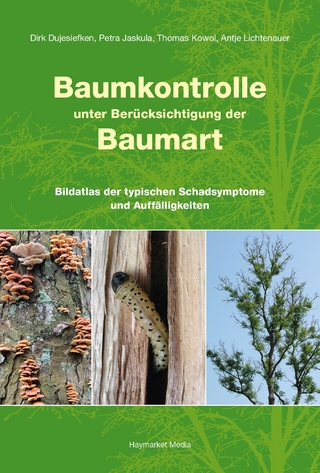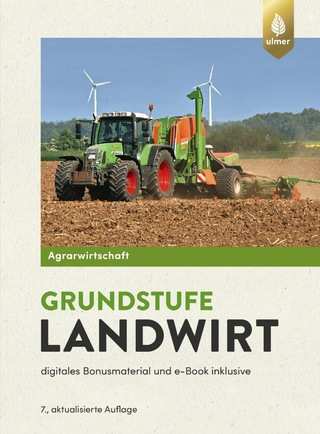
The World of Sea Cucumbers
Academic Press Inc (Verlag)
978-0-323-95377-1 (ISBN)
The involvement of Indigenous peoples and minorities in various community-level initiatives and on the cultural significance/impact of sea cucumbers in many regions are also examined. Finally, breakthroughs and emerging biotechnologies centered on sea cucumbers are presented.
Annie Mercier is a Professor at the Department of Ocean Sciences of Memorial University (Canada) where she pursues wide-ranging research interests around marine benthic communities and their response to exogenous factors and environmental stressors. She and her team study life-history strategies and species interactions at various scales in a broad variety of taxa (with a focus on echinoderms, molluscs, and cnidarians) from coastal, polar and deep-sea environments. Her areas of expertise also include the management and conservation of ecologically and commercially important marine species. As of 2022, Annie Mercier had co-edited 4 academic books, and co-authored more than 200 scientific publications, including 12 refereed chapters, over 130 peer-reviewed articles and several technical reports. She also holds editorial positions inside two scientific journals and co-chairs the IUCN Species Survival Commission Specialist Group on Sea Cucumbers. Prior to her faculty position at Memorial University, Annie Mercier conducted research in the Indo-Pacific islands together with her partner Jean-François Hamel. Their research on the fundamental biology and reproductive habits of key commercial sea cucumbers, in partnership with international organizations (FAO, IUCN, CITES) and foreign institutions, facilitated the development of numerous fisheries and aquaculture programs. The pair also published popular books and articles on wildlife, diving, and environmental issues, and assisted with the production of museum exhibitions and film documentaries. To this day, they continue to work, publish and deliver conferences on the ecology and management of marine resources in Canada and abroad. Jean-François Hamel is a research scientist and co-founder of the Society for the Exploration and Valuing of the Environment, based in Canada. He conducts fundamental studies on the diversity of life-history strategies in boreal and tropical marine invertebrates world-wide, with a focus on echinoderms and cnidarians, and an interest in their management and conservation. He specializes in the interplay between environmental factors and the ecology of early life stages. As of 2022, he had co-edited 4 academic books, and co-authored 12 refereed book chapters, over 130 peer-reviewed articles and several technical reports, totalling more than 200 scientific publications. As an echinoderm specialist with over 35 years of experience, Jean-François Hamel has worked around the world (e.g. Brazil, Belize, China, Ecuador, Indonesia, Maldives, Marshall Islands, Mexico, Panama, Solomon Islands), often with his partner Annie Mercier, in collaboration with international organizations (FAO, IUCN, CITES) and foreign institutions. He regularly travels as a scientific consultant to deliver presentations and help with the development of sea cucumber nurseries, grow-out facilities and sea ranching initiatives. He is also building partnerships with Northern communities of Canada around the sustainable exploitation of benthic resources. Aside from being passionate scientists and fierce advocates of marine resources conservation, Jean-François Hamel and Annie Mercier have authored numerous popular articles on wildlife, diving, aquarium hobby, travel destinations and environmental issues in magazines around the world. They also write coffee table books and are periodically involved in the production of film documentaries Andy Suhrbier is a Research Biologist at the Pacific Shellfish Institute (Olympia, Washington, USA) where he focuses on multiple aspects of marine molluscs and echinoderms. For over 22 years he has been involved in aquaculture development, marine benthic/water quality studies, mapping of marine habitats including eelgrass and aquaculture, project development and management. He developed shellfish certification standards for the west coast shellfish industry for the certification entity: “The Food Alliance. He maintains 4 water quality monitoring stations related to ocean acidification, as part of the Northwest Association of Networked Ocean Observing Systems (NANOOS). Intrigued by population declines and the multitrophic aquaculture potential of the giant red sea cucumber (Apostichopus californicus) he started leading sea cucumber research in 2015. Current sea cucumber work involves genetics, aquaculture, multitrophic aquaculture, resource use and enhancement in Washington state, California, Oregon, and Alaska, USA. Working with the shellfish, seaweed and kelp industries, academia, state agencies, native tribes and nations and NGO’s he pushes for advances for upland and marine aquaculture of Apostichopus californicus with the seaweed dulse (Palmaria palmata), mussels (Mytilus galloprovincialis and Mytilus trossulus), cockles (Clinocardium nuttallii) and oysters (Ostrea lurida and Crassostrea gigas). He has chaired echinoderm sessions and reviewed many North American and international journal articles and proposals. He has authored and co-authored multiple sea cucumber reports and standard operating procedures with a goal to advance knowledge and ultimately see commercial scale sea cucumber aquaculture on the USA west coast. Chris Pearce is a research scientist with Fisheries and Oceans Canada at the Pacific Biological Station (Nanaimo, British Columbia, Canada), where he conducts studies on sustainable aquaculture, focusing on the effects of various environmental factors on the biology, physiology, and genomics of a variety of cultured freshwater and marine invertebrates (i.e. geoduck clams, giant red sea cucumbers, green/purple/red sea urchins, Manila clams, Pacific oysters, and signal crayfish). He works closely with the commercial shellfish and finfish culture industries and various First Nations in British Columbia to address issues related to the ecological, economical, and social sustainability of invertebrate aquaculture, results from his research having contributed to the development of various federal aquaculture policies and frameworks. He is a specialist on integrated multi-trophic aquaculture (IMTA) and lower-trophic-level aquaculture, routinely advising provincial, national, and international companies, organizations, research networks, and governing bodies on various facets of those two fields. He is currently working with the salmon aquaculture industry in western Canada to examine the feasibility of sea cucumbers to mitigate net biofouling and organic particulate accumulation at commercial fish farms. As of 2022, he had authored/co-authored 120 scientific publications, including 90 peer-reviewed journal articles and 30 governmental/industry technical reports. He holds editorial positions with two scientific journals, maintains adjunct status at two universities (Vancouver Island University and University of Victoria), and is past-president of the Aquaculture Association of Canada.
Section I: Background and Overview 1. An overview of taxonomic and morphological diversity in sea cucumbers (Holothuroidea: Echinodermata) 2. Perspectives on sea cucumber knowledge syntheses 3. A journal dedicated to holothuroids: the SPC Beche-de-mer Information Bulletin
Section II: Sociology 4. The McDonaldization of the Sea Cucumber: Changes in Foodways of an Ancient Delicacy in Northeastern Asia 5. Sea cucumbers in Chinese daily life 6. Beyond beche-de-mer : sea cucumber in non-traditional food products, health supplements, and biotechnology 7. Mystery, Muse, Monster: Sea cucumbers in popular culture 8. Women in sea cucumber fisheries and aquaculture – can we make their participation equal and fair? 9. Artisanal processing and consumption of sea cucumbers: stories from the Philippines and Fiji Islands 10. Importance of sea cucumber fisheries and trade for small island communities: a case study in Papua New Guinea 11. Aspects of the Relationship between the Giant Red Sea Cucumber, Apostichopus californicus, and the Indigenous People of the Northwest Coast of North America 12. Perspectives on sea cucumber use and research in the Canadian Arctic with special attention to Sanikiluaq (Qikiqtait, Nunavut) 13. Sea cucumber crime
Section III: Biology 14. Knowledge of biodiversity and reproduction in sea cucumbers from southern South America to Antarctic Peninsula 15. Adult fission as an auxiliary reproductive mode in holothuroids, with a detailed look at Holothuria atra and Stichopus chloronotus 16. Morphological diversity, development, and biology of sea cucumber larvae 17. Biology and ecology of wild juvenile sea cucumbers: what do we know? 18. A preliminary survey and analysis of beaching events involving sea cucumbers 19. Autotomy (evisceration) and regeneration of dendrochirotid sea cucumbers 20. Locomotor, feeding, and reproductive behaviours of sea cucumbers with a focus on Apostichopus japonicus 21. Swimming sea cucumbers 22. Glowing sea cucumbers: Bioluminescence in the Holothuroidea 23. Diversity of coelomocytes in the class Holothuroidea 24. Vibratile cells and hemocytes in sea cucumbers – clarification and new paradigms
Section IV: Ecology 25. Chemical ecology of sea cucumber reproduction 26. Decorator sea cucumbers: an overview of epibiotic associates of Holothuria floridana and H. mexicana 27. Adaptations of pearlfish (Carapidae) to their life inside sea cucumbers 28. Sediment processing: the foremost ecological role of tropical deposit-feeding sea cucumbers 29. Gut microbiota of sea cucumbers, with a focus on Apostichopus japonicus 30. Sea cucumbers under ocean acidification and warming 31. Sea cucumbers in a high temperature and low dissolved oxygen world: an overview focusing on Apostichopus japonicus 32. Sea cucumber response to microplastic pollution
Section V: Research and Development 33. Exploring body-size metrics in sea cucumbers through a literature review and case study of the commercial dendrochirotid Cucumaria frondosa 34. Apostichopus japonicus colour morphs: physiology and molecular regulation mechanisms 35. Neuropeptides and neuroendocrine signaling systems in sea cucumbers 36. Mutable collagenous tissues in sea cucumbers 37. Novel biomaterials and biotechnological applications derived from North Atlantic sea cucumbers: A systematic review 38. Sea cucumbers and cheese making: exploring the use of milk coagulant obtained from the digestive tract of Holothuria scabra 39. Sea cucumber aquaculture start-up experience: the case of the Maldives 40. Diversifying sea cucumber aquaculture in the Caribbean: the promising example of Holothuria floridana in Panama, Mexico, and Belize 41. Role of sea cucumbers as an ecosystem service in land-based aquaculture
Section VI: Species and Their Exploitation Around the World 42. Biology, ecology, aquaculture, and commercial products of Apostichopus californicus 43. Ensuring long term sustainability of the fishery for Apostichopus californicus in British Colombia (Canada) through collaborative science and adaptive management 44. Dynamic history and status of fisheries for the sea cucumbers Apostichopus californicus and A. parvimensis on the west coast of the United States of America 45. Can cucumber fisheries be sustainable? The Mexican case study 46. Aquaculture of the chocolate chip sea cucumber Isostichopus badionotus in Yucatan, Mexico: progress and challenges 47. Sea cucumber fisheries in Northern Europe 48. Mediterranean sea cucumbers: biology, ecology and exploitation 49. History of the fishery and aquaculture of the sea cucumber Apostichopus japonicus in Russia 50. Ecology and culture of the warty sea cucumber (Stichopus cf. horrens) in the Philippines 51. Future prospects for sea cucumber mariculture in Papua New Guinea and the Pacific Islands
| Erscheinungsdatum | 26.08.2023 |
|---|---|
| Verlagsort | Oxford |
| Sprache | englisch |
| Maße | 216 x 276 mm |
| Gewicht | 2560 g |
| Themenwelt | Weitere Fachgebiete ► Land- / Forstwirtschaft / Fischerei |
| ISBN-10 | 0-323-95377-8 / 0323953778 |
| ISBN-13 | 978-0-323-95377-1 / 9780323953771 |
| Zustand | Neuware |
| Informationen gemäß Produktsicherheitsverordnung (GPSR) | |
| Haben Sie eine Frage zum Produkt? |
aus dem Bereich


